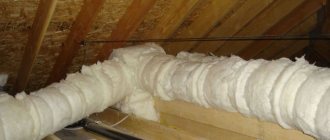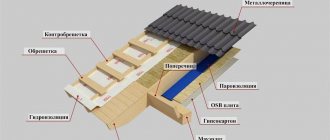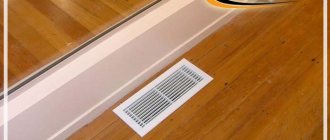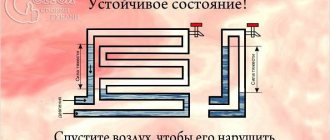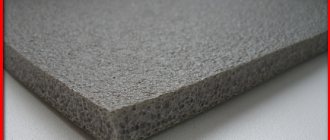Natural ventilation channels
In previous articles on this topic, air circulation patterns in a house or apartment were published, as well as the advantages and disadvantages of a natural ventilation system.
For effective ventilation, each room of the house must have two ventilation devices: one for air supply, the other for removing air from the room.
Each room in a house or apartment is equipped with a supply and exhaust natural ventilation device according to one of three options:
- A supply valve in a window or external wall for air flow. A flow opening into an adjacent room with an exhaust duct for removing air (a hole in a door or an internal wall, partition).
- For air supply there is a flow hole from the adjacent room with a supply valve, and an exhaust ventilation duct to remove air.
- A supply valve for inflow, and an exhaust ventilation channel for removing air.
Check whether in the house or apartment where you currently live, whether all rooms have supply and exhaust ventilation devices?!
In which rooms should exhaust ventilation ducts be installed?
Exhaust ducts for natural ventilation must be provided from the following areas of the house:
- Sanitary facilities - bathroom, toilet, laundry room.
- Kitchens.
- Dressing room, storage room - if the doors of the premises open into the living room. If the doors open onto a corridor (hall, kitchen), then you can do one of two things: arrange an exhaust duct from the premises or install a supply valve in a wall or window.
- The boiler room must have both a ventilation duct and a supply valve.
- From rooms separated from rooms with a ventilation duct by more than two doors.
- On the floor above the first, if there are entrance doors from the stairs to the floor, ventilation ducts are made from the rooms indicated above, and/or from the corridor, hall.
- On the floor above the first, in the absence of entrance doors from the stairs to the floor, a ventilation duct and a supply valve are installed in each room of the floor.
In other rooms of the house that do not have natural ventilation exhaust ducts, a supply valve must be installed in a window or in a wall and a flow hole into the adjacent room .
In addition, natural ventilation exhaust ducts are used for ventilation:
- Spaces under the wooden floor of the first floor on joists.
- Basement space to protect against radioactive radon gas.
- Sewer pipe riser.
Mixed exhaust ventilation - natural & mechanical
For residential buildings, mechanical ventilation with partial use of natural ventilation systems for the supply or removal of air (hereinafter referred to as mixed ventilation ) should be provided during periods of the year (summer) when microclimate parameters and air quality cannot be ensured by natural ventilation (clause 7.1.4 SP 60.13330.2016).
Building rules (clause 6.5.8 SP 60.13330.2016) require, when installing apartment heating in residential apartment buildings, for premises in which gas-consuming equipment is to be placed, to provide two methods of air removal at once:
- natural ventilation;
- and mechanical exhaust ventilation.
But the air flow can be either through natural or mechanical supply ventilation.
To ensure the safety of using gas in houses and apartments, I recommend using mechanical exhaust ventilation, along with natural ventilation, always and in all rooms where any gas-using equipment is installed (gas stove, hot water heater, gas boiler).
Mixed ventilation with a fan at the entrance to the duct will protect your home in the event of:
- in case of insufficient draft in the natural ventilation channel in summer, when the outside air temperature rises above +5 ° C;
- when gas alarms for fuel and carbon monoxide are triggered, if the fan is connected to the alarm.
Read: Gas alarm - protecting your home from fuel and carbon monoxide leaks
For mixed exhaust ventilation, one common channel can be used. The fan is connected to the common duct as shown in the figure below, instead of a kitchen hood.
Location and dimensions of ventilation ducts
The minimum side size of the natural ventilation channel is 10 cm, and the minimum cross-sectional area is 0.016 m2, which approximately corresponds to the diameter of a standard ventilation channel pipe - 150 mm.
A channel of minimum size will provide air exhaust in a volume of 30 m3/hour with a vertical pipe length of more than 3 m. To increase the efficiency of the exhaust, increase the cross-sectional area of the channel or the length of the channel. Channels less than 2 m long do not provide the necessary intensity of natural ventilation.
In practice, the length of the ventilation duct on a floor is usually determined by design considerations - the number and height of the upper floors located above, the height of the attic, the length of the pipe above the roof. On the floor, the length of all channels must be the same.
This is done so that the traction force in each channel on the floor is approximately the same.
The cross-sectional dimensions of the channels on the floor are often made the same, but for design reasons - it’s more convenient. The performance of the ventilation channel in a particular room on the floor is adjusted by choosing the size of the ventilation grille.
Ventilation ducts from the premises of the house on different floors are placed side by side, combining them into a block of ventilation ducts.
For design reasons, they try to lay several ventilation ducts from rooms on the same floor side by side, in one place - to create a block of ventilation ducts.
| Examples of rational combination of exhaust ventilation ducts on the floor into one block (riser). |
A block of ventilation ducts in stone houses is usually placed inside the load-bearing internal wall of the house or attached to the wall.
The block is laid out from masonry materials, for example, brick. In brickwork, it is convenient to make channels with a cross-section that is a multiple of the size of the brick, taking into account the thickness of the joints - 140x140 mm
.
(1/2 x 1/2 brick, 196 cm2) or 140x270 mm
. (1/2 x 1 brick, 378 cm2)
Expanded clay concrete ventilation block, two-channel, 390x190x188 mm. The flow area of one channel is 168 cm2
Concrete blocks for laying ventilation ducts in a private house.
Block height 33 cm, width 25 cm, wall thickness 4 cm. The flow area of one channel is 12x17 cm (204 cm2) Hollow concrete blocks are produced, specially designed for laying ventilation ducts.
A block of ventilation ducts made of masonry materials must be supported on a foundation or on a reinforced concrete floor.
In other cases, for example, in wooden or frame houses, a block of ventilation ducts is assembled from plastic or galvanized steel pipes. The block of pipes is covered with a box.
How to combine several channels into one channel
In a private house, the number of channels is small, so there is no need to combine air flows from several channels (rooms or floors) into one, as is often done in apartment buildings. Each natural ventilation channel in a private house should begin in the room and end at the head on the roof. Any combination of two or more channels impairs ventilation performance.
In some cases, there is still a need to combine several channels, to combine them into one common natural ventilation channel.
Read:
How to combine several channels into one common ventilation channel
Ventilation channel performance
Performance of a single exhaust ventilation duct with a cross-section of 12x17 cm (204 cm2) made of concrete blocks, depending on the height of the duct and the room temperature:
Capacity of natural ventilation channels with a cross section of 12 x 17 cm (204 cm2) depending on the height of the channel and the room temperature (at an outside air temperature of 12 ° C)
To determine performance for intermediate channel heights, plot the channel height versus performance graph.
Similar tables can be found for ventilation ducts that are made of other materials.
However, for ventilation ducts of the same cross-section (204 cm2), but made of other materials, the performance will differ slightly from that indicated in the table.
For a channel of a different cross-section, the performance value from the table can be proportionally increased or decreased.
To increase the performance of a ventilation channel of the same height, it is necessary to proportionally
increase the cross-sectional area of the channel. To do this, for example, choose a concrete block with a larger hole, or use two or three channels of the above size to ventilate one room.
Recuperator
When arranging supply and exhaust ventilation in private homes, significant savings come from the use of systems with heated supply air, called “supply and exhaust ventilation with recovery.”
Scheme of operation of ventilation with recuperation Source airclimat.ru
Recovery means the process of recycling heat from internal exhaust air with a temperature tb, which is emitted into the street during a cold period with a high temperature, to heat the supply external air. The process of heat recovery occurs in special heat recuperators: plate recuperators, rotating regenerators, as well as in heat exchangers installed separately in air flows with different temperatures (in exhaust and supply units) and connected by an intermediate coolant (glycol, ethylene glycol).
The last option is most relevant in the case when the supply and exhaust are spaced along the height of the building, for example, the supply unit is in the basement, and the exhaust unit is in the attic, however, the recovery efficiency of such systems will be significantly less (from 30 to 50% compared to the PPV in one building.
Calculation of natural ventilation of a private house
The building regulations specify the minimum required capacity of natural ventilation ducts. Typically, people feel better when more fresh air is supplied to the room than specified in the standards. The performance of the natural ventilation channel very much depends on atmospheric and other variable factors (air temperature inside and outside, wind pressure and direction, resistance to air flow into the room). All this suggests that for a private house there is no point in scrupulously and accurately performing calculations . I recommend rounding the calculation results towards greater productivity of natural ventilation channels. During operation, if necessary, the channel capacity can be easily reduced.
Calculation of natural ventilation is carried out in order to determine the size of ventilation channels based on the volume of air removed.
When determining the volume of air removed through natural ventilation ducts, it is taken into account that air enters rooms with supply valves from the street, then this air flows into rooms with exhaust ducts, and is removed through the ducts again to the street.
The calculation is carried out for each floor of the house in the following sequence:
- Guided by the standards (see here), they determine the amount of the minimum volume of air that must come from the street to ventilate
all rooms with supply valves - Qp,
m3/hour
. - According to the standards, they determine the amount of the minimum volume of air that must go outside to ventilate
all rooms equipped with an exhaust ventilation duct - Qv,
m3/hour
. - Compare the calculated minimum values of air inflow from the street (Qp, m3/hour)
and outflow to the street (Qb,
m3/hour)
.
Usually one of the quantities turns out to be greater than the other. The larger of the two values is taken as the minimum design capacity of all exhaust ventilation channels on the floor
- Qр,
m3/hour
. - Based on the vertical dimensions of the house, the height of the natural ventilation channel on the floor is determined.
- Knowing the height of the ventilation channel and the total estimated minimum productivity of all channels on the floor (Qр, m3/hour),
the total number of standard channels made of concrete blocks is selected from the table (see above).
The total productivity of the selected number of standard channels must be no less than the value of Qр, m3/hour. - The selected number of standard ducts are distributed between the rooms of the house, which must be equipped with exhaust ventilation ducts. When distributing, take into account the need to ensure standard air exchange in each individual room with a ventilation duct.
Video description
For more information about recuperators, see the following video:
It is important! Including a recuperator in the supply and exhaust system allows you to save up to 70-90% of the heat of the exhausted room air.
Phases of operation of the recuperator in the supply and exhaust ventilation mode in the house Source moydomik.net
An example of calculating the natural ventilation of a private house
For example, let's calculate natural ventilation in a one-story house with a total floor area of 120 m2. The house has five living rooms with a total area of 90 m2, a kitchen, a bathroom and toilet, as well as a dressing room (storage area) with an area of 4.5 m2. The height of the premises is 3 m. The house has ground floors on wooden joists with natural ventilation of the underground space through a ventilation duct. The height of the ventilated space under the floor is 0.3 m. We use concrete blocks to install ventilation channels - see above.
1.
In a private house, the air exchange standard for living rooms where air comes from the street is determined based on at least a single exchange of air volume per hour (air exchange rate = 1
1/hour
).
Then, the air flow from the street
for ventilation of five rooms: Qp = 90
m2
x 3
m
x 1
1/hour
= 270
m3/hour
;
2.
Air exchange standards for ventilation of rooms and spaces with exhaust ducts: kitchen 60
m3/hour
, bathroom and toilet 25
m3/hour
in each room;
The air exchange rate in the dressing room and the space under the floor on the joists is 0.2 1/hour
.
Then, to ventilate these rooms, it is necessary to remove to the street:
Qв1 = 60
m3/hour
+ 25
m3/hour
+ 25
m3/hour
= 110
m3/hour -
from the kitchen, bathroom and toilet;
Qв2 = 4.5 m2
x 3
m
x 0.2
1/hour
= 2.7
m3/hour
- from the dressing room;
Qв3 = 120 m2
x 0.3
m
x 0.2
1/hour
= 7.2
m3/hour
- from the space under the floor on the joists;
Total: Qв = 110 m3/hour
+ 2.7
m3/hour
+ 7.2 m3/hour = 119.9
m3/hour
3.
Let's compare: Qп > Qв.
We accept the minimum calculated total productivity of all exhaust ducts on the floor: Qр = Qп = 270 m3/hour
4.
For a one-story house, the height of the exhaust ventilation duct, taking into account the height of the attic, is assumed to be 4
m
.
5.
According to the table, for a room air temperature of 20 °C and a channel height of 4
m
, we find: the productivity of one standard ventilation channel with an area of 204
cm2
is equal to 45.96
m3/hour
.
(or 204: 45.96 = 4.44 cm2
- the channel cross-section required to pass 1
m3/hour
of air.) Then, the total minimum number of standard ventilation channels made of concrete blocks in the house is: 270
m3/hour
: 45.96
m3 /hour
= 5.87.
A minimum of 6 exhaust ducts
is required to ensure minimum natural ventilation performance in the house.
6.
There are four rooms in the house that need to be equipped with exhaust ventilation ducts - a kitchen, a bathroom, a toilet and a dressing room.
In addition, for design reasons, two ducts are required to ventilate the space under the floor. Total - 6 channels. A minimum of 6 exhaust ducts
are required to be installed on a floor in the house, based on the number of rooms and spaces where the installation of a ventilation duct is necessary.
7.
In addition, one more condition must be met - to ensure air exchange according to the standard in certain rooms - in the kitchen at least 60
m3/hour
, in the bathroom and toilet 25
m3/hour,
in the dressing room 2.7
m3/hour,
in the space under the floor 7.2
m3/hour
.
To fulfill this condition in the kitchen, one channel of the cross-section we have chosen is not enough. In order to use standard elements for laying channels, we decide to place a block of two standard ventilation channels
(2x204
cm2
) in the kitchen.
In the bathroom, toilet and dressing room we make one standard natural exhaust ventilation channel with a cross-section of 204 cm2
each.
To ventilate the space under the floor, we install two channels of 204 cm2 each. Thus, in total, to ensure minimum ventilation performance in each room with an exhaust ventilation duct, the house needs 7 natural ventilation channels
.
As a result, we finally accept 7 channels for construction and check that the ventilation performance meets the design standards:
— in the kitchen there is a block of two ventilation channels (2x204
cm2
) with a total capacity of 45.96
m3/hour
x 2 = 92
m3/hour
.
which is more than the standard for a kitchen of 60 m3/hour
;
— in the bathroom and toilet we install a block of two ventilation channels (2x204 cm2
) with a capacity of one channel of 45.96
m3/hour
, which is more than the standard of 25
m3/hour
;
— in the dressing room we install a single-channel ventilation unit (1x204 cm2) with a capacity of 45.96 m3/hour
, which is more than the standard calculation of 2.7
m3/hour
.
— to ventilate the space under the floor, we make two channels with a total capacity of 45.96 m3/hour
x 2 = 92
m3/hour
, which is more than the calculated standard of 7.2
m3/hour
.
— the total productivity of all seven ventilation channels on the floor is 92 m3/hour
+ 45.96
m3/hour
+ 45.96
m3/hour
+ 45.96
m3/hour
+ 92
m3/hour
= 322
m3/hour
, which exceeds the calculated standard productivity ventilation on the floor is 270
m3/hour
.
From the calculation results it is clear that the minimum required ventilation capacity of rooms with supply valves is provided with a small margin (322 m3/hour
> 270
m3/hour
). At the same time, the ventilation performance in some rooms with an exhaust duct exceeds the standard tens of times.
Exhaust ducts in the kitchen, bathroom, toilet and dressing room, as well as spaces under the floor, participate in the ventilation of other rooms in the house.
Therefore, the performance of exhaust ducts in these rooms is adjusted taking this circumstance into account. Do not reduce ventilation performance in these rooms, for example, by installing small ventilation grilles at the entrance to the duct.
It should be noted that the operation of the fan in the hood above the kitchen stove or in the bathroom should not be taken into account when calculating the air exchange of natural ventilation in these rooms.
The above method for calculating ventilation channels is simplified and not professional. It is better to entrust the design of natural ventilation in the house to specialists.
Ventilation duct above the roof
When there is wind, in air flows flowing around the roof and other obstacles, zones of rarefaction and zones of high pressure are formed, like near an airplane wing. The location of such zones constantly changes depending on the strength and direction of the wind.
If the head of the ventilation duct falls into an area of vacuum, then the draft in the duct increases; if it enters a pressure zone, then the draft in the duct decreases or even overturns, the air begins to move in the opposite direction from the street into the house. It can be especially unpleasant when, in winter, cold air suddenly begins to blow from the ventilation grill into the room.
To reduce the influence of wind on the operation of natural ventilation, the head of the ventilation duct above the roof must be placed at a certain distance.
| Minimum distances of the head of the natural ventilation channel from the house structures. a - on a flat roof with a slope of less than 12 degrees; b - on a pitched roof with the head located closer than 1 m from the ridge; c - the same, but with the head located further than 1 m from the roof ridge; d - location of the head near vertical surfaces (wind barriers). |
Insulation of natural ventilation channels
Cooling the air in the natural ventilation channel leads to a decrease in draft and condensation from the removed air. To protect the ducts from cooling, it is not recommended to place them inside the outer walls of the house.
Ventilation ducts located in external walls, as well as areas passing through an unheated room (attic), must be insulated. It is recommended to insulate areas of ventilation ducts located outside on the roof.
Reduced aerodynamic resistance of ventilation channels
The traction force in the natural ventilation channel also depends on the resistance to air movement along the channel - aerodynamic drag. In order for the resistance to air movement through the channel to be minimal, it is necessary:
- Increase the channel cross-section;
- There should be no local narrowings or expansions in the channel;
- The direction of the channel must be vertical and straight. It is allowed, if necessary, to shift the channel to the side up to 1 m
.
at an angle of no more than 30 degrees
. to the vertical. The natural ventilation channel should not have horizontal sections. - Ensure that the walls of the ventilation duct are smooth. The use of corrugated pipes is not allowed in the natural ventilation system. The walls of the channel made of masonry building materials are carefully leveled, the seams are rubbed.
Where to buy ventilation devices for your home
Ventilation
⇆
Transfer ventilation grilles between rooms
In the natural ventilation system of a private house, on each floor it is necessary to ensure the ability to move air from rooms equipped with supply valves to rooms with exhaust ventilation ducts. To do this, ventilation overflow openings are installed in the doors or in the internal walls between rooms.
The area of the overflow hole for air exiting the room with a supply valve must be at least 200 cm2
.
Usually a gap of 2-3 cm
.
Overflow hole for air entry into the kitchen, bathroom
or to another room equipped with a ventilation exhaust duct, must have an area of at least 800
cm2
. Here it is better to install a ventilation grille at the bottom of the door or in the inner wall of the room.
Transfer ventilation grilles in the doors.
The open cross-sectional area of the grille for a door to a room with an exhaust ventilation duct is at least 800 cm2, for a room with a supply valve - at least 200 cm2. The flow ventilation grille consists of two frames - external and internal. One of the frames has horizontal blinds. The frames are inserted into the door opening on both sides.
When moving from a room with a supply valve to a room with a ventilation duct, air should pass through no more than two ventilation openings (two doors).
It should be noted that through the transfer holes in the doors, not only air, but also sounds easily penetrate from one room to another. Ventilation holes significantly reduce the sound insulation of rooms in the house.
Video description
For a clear overview of ventilation in a private home, watch the video:
Typically, doors from stairwells to floors must be closed for natural ventilation to function properly.
In the attic it is always necessary to install forced ventilation, since the standard natural draft is not provided due to the low height of the ventilation ducts.
Kitchen ventilation
To ventilate the kitchen, builders of a private house must provide a separate ventilation duct into which the exhaust air flow will be sucked.
The channel is mounted from galvanized steel sheets or other stainless materials. The surface of the channel should be smooth so that greasy fumes from the kitchen and soot from the stove do not settle on it. The inlet and outlet openings of the channel are protected by grilles.
As in the whole house, air circulation in the kitchen is carried out by natural and forced methods. Those. vents and windows are opened, or a hood is purchased. The latter option is clearly preferable, since the inability of natural ventilation to cope with the odors that appear during cooking is beyond doubt.





